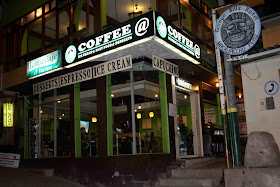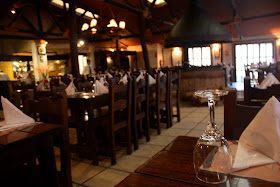
Although I’ll be traveling for two months and through five countries on this trip, already on my third day I hit what might be the highlight: Machu Picchu.
I started off very early after a quick, 5:30 a.m. meal at the Treehouse Restaurant, which is operated by the hostal where I was staying. The yoghurt and bread were all homemade, and for the first time on my trip thus far the orange juice I was served came from real oranges.

I wolfed this down in about five minutes and then, with bus ticket ($14 round-trip) and prepaid entry ticket ($60) in hand, I set off for the bus station to catch a ride up the mountain for the 6:00 a.m. opening of Machu Picchu.
The bus ride only took about fifteen minutes, which, with the stunning and surreal landscape, really heightened my expectations of what I’d find at Machu Picchu. The bus was oddly quiet as all the passengers seemed riveted by the steep, lush mountains out the window and the mist that swirled everywhere as if the Urubamba River that cut through the landscape was boiling and sending steam into the sky. It would have made for a wonderful, 90-minute walk from Aguas Calientes, but the steepness of the climb would be a killer.

When the bus arrived, there was a collective groan at the sight of perhaps one hundred tourists already lined up at the entrance. However, when the gate opened the line moved quickly and I passed through only a few minutes after six a.m. People quickly dispersed, and I found myself mostly alone in an empty landscape, which I admit that I preferred. Machu Picchu was so stunning that the last thing I would have wanted is a bunch of tourists crowding around me and the ruins I’d come to see. After all, how often does one get to visit one of the eight Wonders of the World and have it mostly to one’s self? This changed by mid-morning as large tourist groups began to arrive, but by then I’d seen the main area of Machu Picchu and was ready to hit the surrounding trails.
It’s amazing that there’s still so much debate about who built Machu Picchu and for what purpose. From what I can gather, it was intended as a winter or summer getaway for a very powerful ruler. It also apparently served as a place of escape when the Spanish conquered Peru – the Spanish never knew about Machu Picchu, or if they did then they never made it here. It’s mind-boggling that it was “re-discovered” by Hiram Bingham – former U.S. senator and the inspiration for the Indiana Jones character – less than one hundred years ago when he more or less stumbled upon it with the help of local guides.
One of the most amazing things about Machu Picchu is its very aesthetic, if I can call it that. Like Ankor Wat, and many important temples and shrines in Japan, Machu Picchu is a stunning example of how people long ago found ways to integrate their architecture into the landscape. The use of stones from the mountains helps in this regard, and so do the terracing, the grassy fields, and the hidden, extremely advanced irrigation system they built. There’s really no describing this place, and the photos don’t do justice to how it feels being here. Without tourists around, the quiet is profound and helps give Machu Picchu an even greater power.





One of the first of many surprises for me was the sight of so many llamas.
They more or less stay together and feed, sleep, and poop on the grass (be careful where you walk!). I had about ten of them at once decide to use the same path I was on, and since they’re bigger than I am, and because I’m clueless about their temperament, I hung back and gave them the right of way.

If anyone reading this is planning a trip to Machu Picchu, make a point to arrive as soon as it opens. The mist is a morning phenomenon, apparently, and burns off by around 9:30. Without it, Machu Picchu is still breathtaking, but the sense of mystery is heightened so much when the mist is present. Wandering through and around the stone buildings is a special experience when there is mist swirling everywhere.
It took me only about two hours to see the principle area of Machu Picchu, and as more tourists were starting to trickle in I decided to explore two of the trails. The first one I went along was called the Inti Punko Trail. It’s well worth walking – or should I say climbing – though I’m sure it would be hellish in wet weather. Thankfully, the day was absolutely gorgeous, which is surprising because it was raining when I arrived in Aguas Calientes yesterday morning and remained drizzly and overcast all day. I guess I got lucky with the weather. No complaints here!
With the weather so nice, it made having a picnic with the boxed lunch I’d ordered from my hostal perfect. As you can see, I was given a veggie and cheese sandwich, a granola bar, a tangerine, some dried fruit, a hardboiled egg, and a box of pineapple juice.
I found a nice flat rock with a view of Machu Picchu in the distance and tucked into it while butterflies flittered around me and birds chirped from the surrounding trees. I think I can safely say that it was the most memorable place I’ve ever eaten.

I met some older (and hearty!) Japanese tourists along this trail. As they stepped by to let me pass them I said, “Sumimasen,” which surprised them. We got to talking a little and hiking some together, which was nice, especially since most people I came across there didn’t make eye contact or return my hellos. (What’s up with that, by the way?) They were all in their sixties or early seventies, I’d guess, and didn’t seem at all bothered by the altitude or steep and endless series of steps.
I didn’t make it very far along the trail to the Inca Drawbridge, unfortunately; it got a little hairy along the way as vertigo kicked in. Despite this, heading in that direction gives one a different view of Machu Picchu, as the photos below show.


After five hours at Machu Picchu I decided to head back to town. The place was much more crowded by 11:00 than it had been when I first arrived. I grabbed a seat on the first bus I came across in the lot and said adios to Machu Picchu.
By the way, if you come here and plan to eat, I recommend bringing a packed lunch. The food prices in the small restaurant here are outrageous. I bought a small bottled water and a small bottle of iced tea, which together cost $7. It even costs $1 to use the bathroom, and if you have a need for toilet paper you need to take what you need from a roll in front of the person selling tickets to enter – within view of people lining up to enter Machu Picchu, which is pretty weird.
To cap off the good day I went to a pretty nice restaurant called Pueblo Viejo.
I got there early, which is typical for me, and ordered something off the menu: lomo saltado, a famous dish all over Peru. I also ordered a glass of Tacama Gran Tinto, which is a wonderfully smooth wine made in Ica, Peru. When I’m at home I gravitate toward Chilean wines, such as Odfjello, but I would choose Tacama every time if I could get hold of it. I also got to gorge myself on a complimentary salad bar, which surprised me with its huge, salted maize. This was a great salad bar – the most ruffage I’ve been able to find in three days – and the maize, I decided, tasted something like Kellogg’s Corn Pops. Who knew that such a taste would go well in a salad?

But back to the lomo saltado. Lomo saltado is a simple dish consisting of strips or cubes of steak stir-fried with green onions, a spicy pepper, red onions, and tomatoes, and served with French fries and rice. This version came in a wonderfully balanced sauce of vinegar, soy sauce, and Worcestershire sauce (according to the waiter).
The dish I was served, with hardly a wait, hit all the right notes for me, much to my delight. This was the first Peruvian dish that truly wowed me – and I’ve been expecting to be wowed for several meals now! The beef, delivered fresh from Cuzco, was perfectly cooked and full of juices, while the red onions had a perfect crunch and weren’t overwhelming in their essential onionyness. The French fries and rice, though both starches, were excellent complements to the salty, spicy meal. Although it hit me hard in the wallet at 42 soles (US$14.50) for the lomo saltado and 15 soles for the glass of Gran Tinto ($5.20), it was lip-smacking good. The service was some of the best I’ve had, too, and the interior had real charm. I also enjoyed my window seat where I could watch all the local activity and colors as dusk fell and a nearby school let out.

Pueblo Viejo is located right off the main plaza and around the corner from the produce and meat market. They are open from 10 a.m. – 11 p.m. most nights. Their telephone number is 211-193; their website is www.grupointi.com.
After dinner, despite being quite full and satisfied, I saw a foreigner eating an ice cream cone and knew I had to have one. So I went a few doors down from Pueblo Viejo to Coffee @ (yes, that’s apparently their name) and ordered a single scoop of a triple swirl: vanilla, strawberry, and lucuma (a Peruvian fruit that is orange-brown and tasted to me like caramel).















































